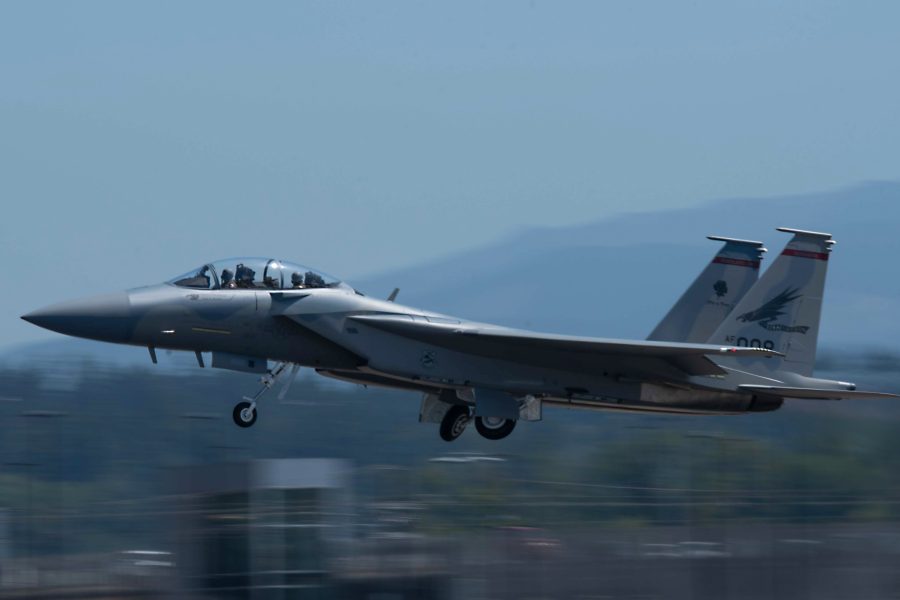Just a few weeks after the Air Force unveiled the F-47 and with the Navy on the verge of awarding a contract for its sixth-generation fighter, the head of U.S. Indo-Pacific Command warned that China is out-producing the U.S. in advanced fighters, and air supremacy, once the exclusive purview of the U.S., is now something that neither country can achieve in the region.
Adm. Samuel J. Paparo, in an April 10 hearing before the Senate Armed Services Committee, told lawmakers that the People’s Republic of China has “2,100 fighters [and] over 200 H-6 bombers, and they are producing fighters at a rate of 1.2 to 1 over the United States.” He also warned that “their advanced air-to-air missile/long range air-to-air missiles also present a tremendous threat” to the U.S.
Paparo was referring to the Chinese PL-15 and PL-17 air intercept missiles, the latter of which is reported to have a range of more than 200 miles, far outclassing the range of the U.S.’s main radar-guided dogfight missile, the AIM-120D Advanced Medium-Range Air-to-Air Missile (AMRAAM), which has a range of about 100 miles.
The disparity in the range of these weapons is the main reason the Air Force is developing the AIM-260 Joint Advanced Tactical Missile, which will extend the reach of U.S. fighters to roughly match that of the PL-17. The JATM is highly classified; it was to have been fielded in 2022, but the Air Force has only said the missile is in test.
China is reportedly also building its premiere stealth fighter, the J-20, at a rate of 40-50 airframes per year. The top U.S. air dominance fighter, the F-22, has been out of production since 2010. The Air Force awarded a contract for the F-22’s successor, the F-47 to Boeing on March 21, and a contract for the F/A-XX, the Navy’s counterpart, is in the final stages of approval. Boeing and Northrop Grumman are the finalists.
The importance of these new fighters was clear in Paparo’s comment.
“If you don’t hold the high ground along the first island chain, you are vastly limited in your ability to operate,” he said, adding that “ceding air superiority is not an option if we intend to maintain a capability against our adversaries and the ability to support our allies.”
Asked by committee chair Sen. Roger Wicker (R-Miss.) if China “is now capable of denying us air superiority in the first island chain,” Paparo replied that “air supremacy is the complete mastery of the air” and “neither side will enjoy that.”
The first island chain refers to an arc of nations and islands including Indonesia, Japan, the Philippines and Taiwan that has traditionally been the limit of China’s military sphere of influence in the Pacific. In recent years, however, China has been expanding the reach of its aircraft, ships, and missiles to reach as far as Guam.
In addition to the new air dominance fighters, Paparo also touted the value of the existing F-15E and its upcoming upgrade, the F-15EX. Specifically, he praised the EX’s “dominant electronic warfare capability, in addition to the already dominant elements of range, speed sensors and payload of the Mighty Eagle.” Paparo noted that he is a fan of the F-15, having flown it as an exchange pilot with the Air Force.
Sen. Ted Budd (R-N.C.) noted that F-15Es from the 336th Fighter Squadron from Seymour Johnson Air Force Base in his state recently arrived at Kadena Air Base in Japan, and asked Paparo what mission it will perform and the value the F-15E provides INDOPACOM
Paparo said the air units at Kadena are “our on-point, contact layer, immediately able to impose costs” on a regional aggressor and to provide “immediate ability to achieve ephemeral air superiority in the [area of responsibility.]”
“The air wing at Kadena is a critical, mobile, dynamic capability that is just not fixed in Kadena, but has the ability to move throughout the AOR…under the principles of Agile Combat Employment,” Paparo added.
ACE, as the Air Force calls it, is an operational concept where small teams of Airmen disperse to operate from remote or austere airfields. It is “the foundation on which the larger forces would flow in, in the event of a conflict … so it’s absolutely crucial,” Paparo said.
Paparo said the Air Force will be working on ACE during this summer’s Northern Edge exercise, saying it is “the means by which we achieve more dynamism among the force.” He told Sen. Dan Sullivan (R-Alaska) that Adak, one of the westernmost islands in the Aleutian Islands chain, will figure prominently in that exercise.
Sullivan urged Paparo that INDOPACOM should “re-open” disused facilities on Adak, because Chinese officials have approached the Aleut Corporation, which administers the island for native Alaskans, about using it as shipping hub with a 100-year lease, something Sullivan said should not be permitted to happen.
Paparo agreed: “I think it would be bad, because this is [China’s] modus operandi in the Belt and Road Initiative. Imagine having the Belt and Road Initiative include Alaska.”
